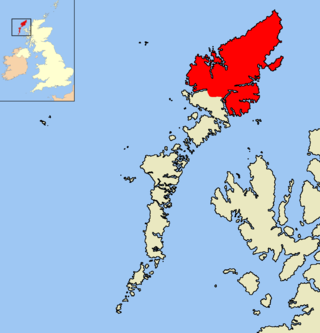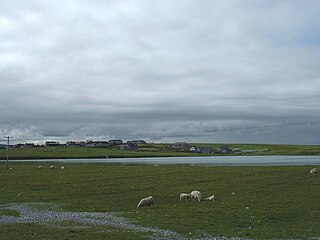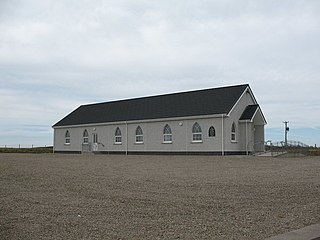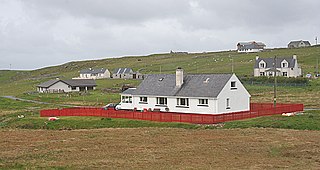
The Isle of Lewis or simply Lewis is the northern part of Lewis and Harris, the largest island of the Western Isles or Outer Hebrides archipelago in Scotland. The two parts are frequently referred to as if they were separate islands. The total area of Lewis is 683 square miles (1,770 km2).
Great Bernera, often known just as Bernera, is an island and community in the Outer Hebrides of Scotland. With an area of just over 21 square kilometres, it is the thirty-fourth largest Scottish island.

Uig, also known as Sgìr' Ùig, is a civil parish and community in the west of the Isle of Lewis in the Outer Hebrides, Scotland. The Parish of Uig is one of the four civil parishes of the Isle of Lewis. It contains the districts of Carloway, East Uig, Bernera and West Uig. The name derives from the Norse word Vik meaning 'a bay'.

Point, also known as the Eye Peninsula, is a peninsula some 11 km long in the Outer Hebrides, Scotland. The majority of Point is connected to the rest of the Isle of Lewis by a narrow isthmus, one mile in length and at one point barely 100 metres wide. The peninsula is just 6 km east of the regional capital of Stornoway, however the district of Point actually starts at the Parkend estate on Stornoway's outskirts. Point is home to around 2,600 people and is one of the few districts of the Western Isles where the population is increasing. There are about 17 villages and hamlets in Point: Melbost (Mealabost), Branahuie, Aignish (Aiginis), Knock, Swordale (Suardail), Garrabost, Lower Bayble, Eagleton, Upper Bayble, Shulishader, Sheshader (Seisiader), Flesherin (Fleisirin), Cnoc Amhlaigh, Portnaguran, Aird, Broker (Brocair), and Portvoller.

Barvas is a settlement, community and civil parish on the Isle of Lewis in Scotland. It developed around a road junction. The A857 and A858 meet at the southern end of Barvas. North is the road to Ness; west takes the traveller to Carloway and the West Side; south runs the road to Stornoway. According to the 2011 Census it still has the highest concentration of Scottish Gaelic speakers in Scotland with 2,037.

Bragar is a village on the west side of the Isle of Lewis in the Outer Hebrides, Scotland, 14 miles from the island's only town, Stornoway. Bragar is within the parish of Barvas, and is situated on the A858 between Carloway and Barvas.

Carloway is a crofting township and a district on the west coast of the Isle of Lewis, in the Outer Hebrides, Scotland. The district has a population of around 500. Carloway township is within the parish of Uig, and is situated on the A858.

Melbost is a traditionally Gaelic-speaking village in Point on the east coast of the Isle of Lewis, in Scotland's north-west. It is largely a crofting township and is about 2+1⁄2 miles east of Stornoway at the head of an isthmus connecting with the Eye Peninsula. Melbost is technically in the district of Point, however it is not located on the Eye Peninsula itself. The RAF Stornoway war memorial is located in the village.
Eilean Chaluim Chille is an unpopulated island in the Outer Hebrides.

The Hebrides were settled early on in the settlement of the British Isles, perhaps as early as the Mesolithic era, around 8500–8250 BC, after the climatic conditions improved enough to sustain human settlement. There are examples of structures possibly dating from up to 3000 BC, the finest example being the standing stones at Callanish, but some archaeologists date the site as Bronze Age. Little is known of the people who settled in the Hebrides but they were likely of the same Celtic stock that had settled in the rest of Scotland. Settlements at Northton, Harris, have both Beaker & Neolithic dwelling houses, the oldest in the Western Isles, attesting to the settlement.

Mealista was a township in the west of the Isle of Lewis. It is currently largely uninhabited due to the Highland Clearances, which occurred there in 1838. The beach is a visitor attraction.
Pabay Mòr or Pabaigh Mòr is an uninhabited island in the Outer Hebrides of Scotland.

Branahuie is a village on the Isle of Lewis in the Outer Hebrides, Scotland. Branahuie is within the parish of Stornoway, and is situated on the A866. It is also close to Stornoway, Stornoway Airport and Melbost.

North Dell is a village on the Isle of Lewis in the community of Ness, in the Outer Hebrides, Scotland. North Dell is within the parish of Barvas. It lies 5 km south of the Butt of Lewis, between the settlements of South Dell and Cross and comprises 22 crofts. North Dell is reputed to be the best village for the growing of potatoes in Lewis – along with Garrabost in Point!

Swainbost is a village on the Isle of Lewis in the district of Ness, in the Outer Hebrides, Scotland. The name Swainbost meaning Sweins steading is of Viking derivation. The settlement is situated in the parish of Barvas. According to Ronald Black, Swainbost was re-settled during the Highland Clearances in 1842. The island's Anglo-Scottish landlord had expected the crofters evicted from Uig to emigrate and only reluctantly granted them land at Swainbost to avert the threat of violence.

Aird Uig is a village on the Isle of Lewis, in the Outer Hebrides, Scotland. Aird Uig is within the parish of Uig, and is situated on the C40 minor road which joins to the B8011 at Timsgarry. The township includes 700 hectares of common grazings to the east and west of the village.

Timsgarry is a village on the Isle of Lewis, in the Outer Hebrides, Scotland. Timsgarry is home to the Baile na Cille Church and the Uig Museum, noted for its giant Chessmen, discovered in the sands in 1831.
The Outer Hebrides are a unique religious area in contemporary Scotland and Britain. The northern island is dominated by Calvinist 'free churches', and has been described as "the last bastion of Sabbath observance in the UK". It is also home to a unique form of Gaelic psalm singing known as precenting. The southern islands of South Uist and Barra are the last remnants of native pre-Reformation Scottish Catholicism. Barra was once dubbed "the island the Reformation did not reach".

Teampull na Trionaid is a ruined 13th-century Augustinian nunnery at Carinish, on North Uist, in the Outer Hebrides of Scotland.

South Galson is a settlement on the northwest coast of the Isle of Lewis in the Western Isles of Scotland. It is 11 km southwest of Port of Ness. The Galson Primary School closed in 1996. The populations of North Galson, South Galson, and Melbost were 149 in 1999.
















